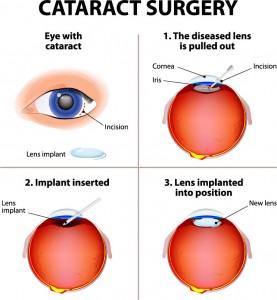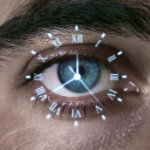Cataract Surgery Overview
ABOUT CATARACT TREATMENT

The decision for cataract surgery is based on when visual difficulties begin to interfere with normal activities of daily living, like driving, reading, work, or hobbies. Poor vision due to cataracts can be a serious health risk. If you can’t see something in your path due to the cataract, you may trip or fall, leading to an injury.
Check out our FREE Cataract Surgery Guide here.
Is cataract surgery at Ophthalmic Consultants of the Capital Region performed in a hospital or in an ambulatory surgery center?
The majority of our patients have their cataract surgery performed as an outpatient procedure at the Albany Regional Eye Surgery Center in Latham, New York. The staff at our surgery center exclusively performs eye surgery, and they are highly experienced in helping patients comfortably go through all the steps of their surgery.
How long does the cataract surgery take?
Cataract surgery takes about 10 minutes in the operating room. Most people are in our surgery center for about 90 minutes, including pre- and post-operative time.
Is cataract surgery performed under a general anesthesia?
Cataract surgery is routinely performed with local anesthesia. We provide intravenous medications to help patients fully relax. We also administer local medicines around the eye so patients don’t feel or see anything during surgery. A small number of patients may require general anesthesia and/or the surgery to be performed in a hospital operating room due to other medical conditions.
Is cataract surgery painful?
Most people say that there is no pain during or after cataract surgery. Some may experience a scratchy sensation (like an eyelash in the eye) and mild soreness for about 24 hours after surgery.
How is the cataract removed?
The cataract is removed during a 10-minute procedure. A small opening (less than 1/8 inch) is made in the front of the eye (the cornea) to allow for the smooth removal of the lens material. An artificial Intraocular Lens (IOL) implant made of silicone or plastic is folded into itself and then inserted into a small incision made in the eye. After insertion, the lens opens and is placed in the proper position. The standard IOL can be selected to correct nearsightedness or farsightedness. Multifocal, accommodative, and toric lens implants are designed to correct vision at all distances, and some can address astigmatism.
After the surgery, will my cataract come back?
After cataract surgery, it is impossible for a cataract to return because the lens of the eye, where the cataract grows, has been completely removed.
However, it is possible for a cloudy film to grow on the lens capsule membrane that is located behind the lens implant. Treatment of this film is simple and done with a laser as an outpatient procedure, involving no postoperative restrictions or downtime for most people.
Learn more about cataract surgery complications by reading this article by Dr. Allen Zieker.
Will I need reading glasses after cataract surgery?
With lens implant technology, our surgeons can choose to correct vision to achieve good uncorrected distance vision in both eyes. This allows most people to pass a Department of Motor Vehicles (DMV) test without glasses. In such a case, it would be necessary to wear reading glasses for fine print, though some large print reading may be possible without glasses.
Risks of cataract surgery
There are risks with every kind of surgery, and cataract surgery is no exception. The risk of complications, such as infection, severe bleeding during surgery, or retinal detachment is very rare. Our doctors have extensive experience performing cataract surgery in unusual circumstances and can fully discuss these risks during an office consultation.
To learn more about possible cataract surgery complications read this article by Dr. Allen Zieker.
Cataract Surgery Recovery
For the first 5 hours after surgery, an eye patch is placed on the healing eye and the effects of anesthesia will be wearing off. During this time we recommend restful activity. After the eye patch is removed, patients can begin administering their post-operative eye drops.
For two weeks after surgery, heavy lifting (more than 20 pounds) is not allowed, and we recommend avoiding eye makeup for two weeks. All restrictions will be fully discussed with you prior to surgery. View information on cataract surgery post-operative instructions.
DIRECTLY AFTER CATARACT SURGERY
Directly after cataract surgery, you will need to have someone drive you home. Most patients feel tired after surgery, so taking a nap is recommended. For the 5 hours after surgery, you’ll need to wear a protective shield over the eye you had the cataract removed.
Recovery from cataract surgery is usually easy and without incident. To ensure the best possible outcome and to minimize your risk of complications after cataract surgery, it’s important to carefully follow your doctor’s post-operative instructions.
Frequently patients experience a dimness in the operative eye typically improving 24 hours post-op. This can be more noticeable in dim light situations.
Most patients see clearly the day after surgery, with little or no discomfort. However, symptoms you may experience include mild pain in or around the eye, itchy and/ or gummy eye, blurred vision, feeling of grittiness in the eye, slight headache, bruising around the eye, and sensitivity and/or halos when looking at bright lights. These are normal symptoms that will diminish within a few days.
FOR THE FIRST 2 WEEKS AFTER SURGERY YOU’LL HAVE THE FOLLOWING RESTRICTIONS:
- Any significant worsening of vision or pain not relieved by Tylenol/artificial tears require calling our office immediately.
- Do not rub the eye at any time; rubbing may cause an infection resulting in vision loss or loss of your eye.
- Must wear the shield while sleeping or napping (secure pointed/tapered end on the bridge of the nose, rim of the shield on brow and cheekbones.)
- No sleeping on the surgical side or stomach.
- No eye makeup, hot tubs or swimming pools for 3 weeks after surgery.
- No bending fully at your waist where your head goes below your heart (e.g. to put your shoes on or pick something up.) You may squat down to pick things up.
- Shower/shampoo with shield taped on and holding a dry washcloth over shield (your back is to the water and your head is tilted up; same rules for the salon/hairdresser.)
- When washing your face, do not touch below the brow or above the cheekbone, do not get soap/ water in the eye.
- For crusting/dried drop residue on lashes, you may wet a tissue and gently drag back and forth over the closed eye to loosen eyelash debris. No pressure is required, just repeat as necessary.
- You may resume REDUCED regular exercise 1-2 days post op; discuss with the doctor.
- Do not blot/push on the eye with a tissue. Wipe tears once they are below the cheekbone.
- You may use preservative-free artificial tears (Refresh, Optive, Genteal or Systane) as much as needed to soothe irritation (do not use within 15 minutes of other post-operative drops.)
- You may wear your old glasses if not too blurry, dark glasses, or a pair of clear safety glasses for your comfort. You may notice between eye surgeries that your eyes don’t work well together; (e.g. depth perception or reading) this is normal.
- Ask your eye care specialist if you are legal to drive during your recovery.
4-6 WEEKS AFTER CATARACT SURGERY:
Within 4-6 weeks after cataract surgery, your eye should be comfortable and your vision should be clear. If you have residual nearsightedness, farsightedness or astigmatism, you may need prescription eyeglasses. Final eyeglass prescriptions for the fine-tuning of distance vision and/or reading will be done 4-6 weeks after your second eye surgery (same time frame if you are only having surgery in one eye.)
Cataract surgery today is very safe and effective, and recovery is very easy. Follow these instructions and you’ll be well on your way to clearer vision.
FIVE CONVENIENT LOCATIONS
Ophthalmic Consultants of the Capital Region has five convenient locations. No need to travel to the big city. You can find advanced eye care right here in your hometown.
We have offices in:
NEXT STEPS
If you think you may have cataracts or have been told you do, it is important to schedule an appointment.
Get in touch with us today at our nearest location to you.





